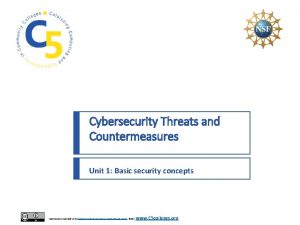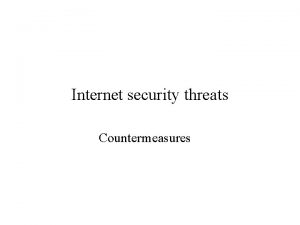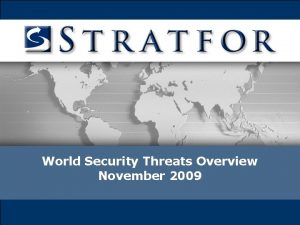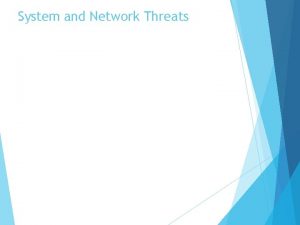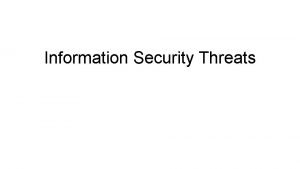CHAPTER 7 Network Security Overview Threats to Network
















- Slides: 16

CHAPTER 7 Network Security

Overview Threats to Network Security Implementing Security Measures Applying Patches and Upgrades Firewalls

Threats to Network Security

Overview: Internal/External Security The Internet essentially works by following rules that are open to the public. If one studies the rules enough, one is bound to find loopholes and weaknesses that can be exploited. The number of individuals, organizations, and institutions connected to the Internet are growing. Connecting to the Internet opens the door to network intruders.

Security vulnerabilities within Linux services BIND Domain Name System Remote Procedure Calls (RPC) Apache Web Server General UNIX Authentication Accounts with No Passwords or Weak Passwords Clear Text Services Sendmail Simple Network Management Protocol (SNMP) Secure Shell (SSH) Misconfiguration of Enterprise Services NIS/NFS Open Secure Sockets Layer (SSL)

Well Known Exploits Each combination of NOS and application software contains it’s own unique set of vulnerabilities and weaknesses. Threats to network security comes from individuals with sophisticated tools. Some of these individuals are often called "script kiddies". Script kiddy is a negative term used to describe immature individuals that use scripts, software programs, or techniques created by other, more skilled crackers.

Implementing Security Measures

Secure Sockets Layer (SSL) SSL was developed by Netscape to provide security for its web browser. It uses public and private key encryption.

Applying Patches and Upgrades

Finding Patches and Upgrades Patches are fixes to existing software code. A NOS manufacturer typically provides security patches. Microsoft now includes the option to use software called Windows Update with its operating systems.

Selecting Patches and Upgrades Software makers recommend installing software security patches immediately. This is done to reduce exposure to known vulnerabilities. Software venders release security updates as soon as they are available. Understanding the effect on the system will help determine if an update, fix, or patch is necessary.

Applying Patches and Upgrades Periodically, NOS vendors issue updates to their network operating systems. These updates have various names: � � � Microsoft Service Packs IBM Fixpacs Novell Patches These updates usually fix bugs or close security holes that have been found in the released version of the OS. Download the updates from the network operating system vendor’s website.

Firewalls

Introduction to Firewalls and Proxies A proxy is software that interacts with outside networks on behalf of a client host. Typically, client hosts on a secure LAN request a web page from a server running proxy services. The proxy server then goes out on the Internet to retrieve the web page. The web page is then copied to the proxy server, this is referred to as caching.

Introduction to Firewalls and Proxies Administrators use Network Address Translation (NAT) to alter the source address of packets originating from a secure LAN. This allows secure LANs to be addressed using private IP addresses. Private IP addresses are not routed on the Internet. An outside hacker cannot directly reach a computer with a private address. Some experts make a distinction between NAT and a firewall. Others look at NAT as part of a comprehensive firewall solution.

Firewall Placement A boundary router connects the enterprise LAN to its ISP or the Internet. The boundary router should only allow HTTP, FTP, mail, and DNS related traffic to the DMZ. The DMZ is designed to keep the inside network clean. The NOS servers in the DMZ should be tightly configured.
 Modern network security
Modern network security Wireless security threats and vulnerabilities
Wireless security threats and vulnerabilities Cyber security threats and countermeasures
Cyber security threats and countermeasures Ecommerce security threats
Ecommerce security threats Wireless security threats
Wireless security threats Common computer security threats
Common computer security threats Privat security
Privat security Explain osi security architecture
Explain osi security architecture Guide to network security
Guide to network security Wireless security in cryptography and network security
Wireless security in cryptography and network security Electronic mail security in network security
Electronic mail security in network security Security guide to network security fundamentals
Security guide to network security fundamentals Security guide to network security fundamentals
Security guide to network security fundamentals دوره owasp
دوره owasp Android security overview
Android security overview Gsm network overview
Gsm network overview Major threats to biodiversity
Major threats to biodiversity


